Fred Kabotie
Fred Kabotie (c. 1900–1986) was a celebrated Hopi painter, silversmith, illustrator, potter, author, curator and educator.
Fred Kabotie | |
|---|---|
| Born | Nawavoy'ma c. 1900 |
| Died | February 28, 1986 |
| Nationality | Hopi |
| Education | Santa Fe Indian School, Santa Fe Public High School |
| Known for | Painting, silversmithing, illustrating |
| Awards | Guggenheim Fellowship |
| Patron(s) | Museum of Modern Art, Elizabeth Willis DeHuff, The George Gustav Heye Center, Grand Canyon National Park |
Background and education
Fred Kabotie was born into a highly traditional Hopi family at Songo`opavi, Second Mesa, Arizona. His family founded Hotevilla, a community faithful to preserving Hopi traditions that were disappearing. He belonged to the Bluebird Clan, and his father belonged to the Sun Clan. Kabotie's Hopi name was Naaqavo'ma, meaning "the sun coming up day after day." His paternal grandfather gave him the nickname Qaavotay, meaning "tomorrow."[1] His teacher at Toreva Day School spelled his nickname "Kabotie", which stuck with him for the rest of his life.[2]
As a child he drew images of Hopi Katsinas with bits of coal and earth pigments onto rock surfaces near his home.[1]
Kabotie wasn't the best student with his spotty attendance at the local day school. He was eventually forced to attend Santa Fe Indian School in Santa Fe, New Mexico, where, he says, "I was supposed to discard all my Hopi belief, all my Hopi way of life, and become a white man and become a Christian." English was the only language students were allowed to speak. John DeHuff became superintendent of the school and went against the prevailing government policy of suppressing Native cultures. DeHuff's wife Elizabeth Willis DeHuff taught painting to the students. She encouraged her students to embrace their culture within their paintings. Kabotie painted Katsinas because he missed home, and sold his first painting for 50 cents to the school's carpentry teacher.[2]
DeHuff was demoted and forced to leave the school because of his encouragement of Native cultures. He convinced Kabotie to continue his education at Santa Fe Public High School. During his summer vacations Kabotie worked with artists Velino Shije Herrera (Zia Pueblo) and Alfonso Roybal (San Ildefonso Pueblo) on archaeological excavations for the Museum of New Mexico.[3] He commenced a long association with local archaeologist Edgar Lee Hewett, joining him at archaeological excavations at Jemez Springs, New Mexico and Gran Quivira.
Early career and personal life
After his graduation in the 1920s, the Museum of New Mexico hired Kabotie to paint and bind books for a salary of $60 per month. Elizabeth DeHuff hired him to illustrate books. The George Gustav Heye Center in New York City commissioned him to paint a series depicting Hopi ceremonies. He also sold works to private collectors. Kabotie primarily painted with watercolor on paper.[3]
In 1930 Kabotie moved back to Shungopavi, Arizona, where he lived for most of his life. He was initiated into the Wuwtsimt men's society and married Alice Talayaonema.[3] They eventually had three children together.
Mary Colter commissioned him to paint murals in her Desert View Watchtower in 1933.
In 1937 Oraibi High school opened for Hopi students, and Kabotie taught painting there for 22 years (1937–1959).[4] He had a strong desire to "spread Hopi culture to young children." Kabotie taught hundreds of Hopi students, some of whom went on to have successful art careers.
He was an advisor at the 1939 Golden Gate International Exposition in San Francisco, California, where he worked with curators Frederic Huntington Douglas and Rene d'Harnoncourt on a show of Native American art.[3]
In 1940 he was commissioned to reproduce the prehistoric murals at Awatovi Ruins, which were shown at the Museum of Modern Art and other locations in the United States.[5] He won the Guggenheim Fellowship in 1945, which enabled him to study Mimbres pottery and write the book, Designs From the Ancient Mimbreños.[3]
Silversmith work
The Museum of Northern Arizona encouraged Kabotie and his cousin Paul Saufkie (1898–1993) to develop a jewelry style unique to Hopi people.[6] They developed an overlay technique, distinct from Zuni and Navajo silversmithing. They created designs inspired by traditional Hopi pottery.[3] A friend and benefactor, Leslie Van Ness Denman, commissioned Kabotie's first piece of jewelry as a gift to Eleanor Roosevelt.[7]
Starting in 1947 the Indian Service and GI Bill funded jewelry classes at the Hopi High School at Oraibi for returning Hopi veterans of World War II. Kabotie taught design and Saufkie taught technique. Each class lasted about eighteen months. The duo created the Hopi Silvercraft Cooperative Guild in 1949 to showcase their students' work. In 1963 the Hopi Guild moved from Oraibi to a newly constructed building at Second Mesa, Arizona, that included a large showroom and workshop space for the artists. Kabotie worked with the Guild in various ways, including serving as president from 1960 until his retirement in 1971.[8] The shop on Second Mesa is rarely used by students today.[6][9]
Later career
Kabotie and his wife represented the US Department of Agriculture at the World Agricultural Fair in New Delhi, India in 1960. The high school at Hopi closed, so upon his return from India, Kabotie worked with the Indian Arts and Crafts Board.[9] His many pursuits left him little time to paint after the 1950s.[10]
He had long assisted other tribal members in marketing their artwork. A lifelong dream was accomplished with the founding of the Hopi Cultural Center, Kabotie was elected as president of the board in 1965. In 1971 the center was officially dedicated.[9]
In 1977, the Museum of Northern Arizona published his biography,[9] Fred Kabotie: Hopi Indian Artist, co-authored with Bill Belknap.[11]
Death and legacy
Kabotie died on February 28, 1986 after a long illness. "The Hopi believe that when you pass away," he said, "your breath, your soul, becomes into the natural life, into the powers of the deity. Then you will become mingled with all this nature again, such as clouds... That way you will come back to your people..."[10]
He was best known for his painting, and is estimated to have finished 500 paintings.[9] His paintings can be seen at gift shops, resorts, cultural centers, and museums all over New Mexico and Arizona.
His son Michael Kabotie (1942–2009) was also a well-known artist.
Artwork
The fact that Kabotie's Hopi culture was almost taken away from him made him realize his mission in art. His mission was to preserve the Hopi culture. His paintings are seen as realistic, and colorful with dynamic solid strong figures. They reflect his love for his culture and the Hopi people. The Kachinas used in his paintings are seen at Hopi ceremonies.
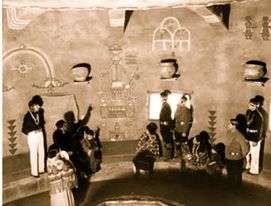
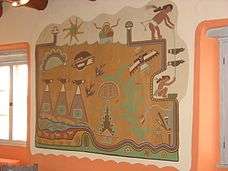
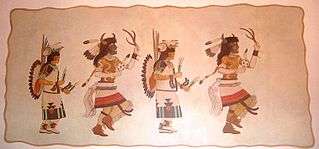
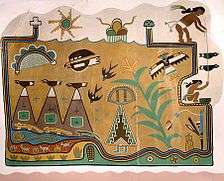
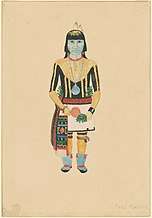
%2C_A_Chief_Kachina_from_First_Mesa.jpg)
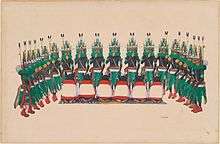
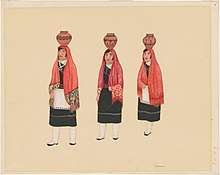
Published works
- Kabotie, Fred. Designs from the Ancient Mimbreños With Hopi Interpretation. Flagstaff, AZ: Northland Publishing, 1982. Second Edition. ISBN 978-0-87358-308-4.
- Kabotie, Fred with Bill Belknap. Fred Kabotie: Hopi Indian Artist. Flagstaff, AZ: Museum of Northern Arizona with Northland Press, 1977. ISBN 0-87358-164-4.
- Kabotie, Fred. Hopi Indian Artist. Museum of Northern Arizona, 1977.
Notes
- Seymour, 242
- Seymour, 243
- Seymour, 244
- Gridley, Marion E. (1960). Indians of Today (Third ed.). Chicago: Towertown. p. 218.
- "Kabotie biography". Archived from the original on 2009-04-09. Retrieved 2009-04-10.
- "Contemporary Artists: Hopi." Archived 2010-11-23 at the Wayback Machine American Museum of Natural History. (retrieved 16 February 2010)
- Seymour, 244-5
- Messier, Pat & Kim (2014). Reassessing Hallmarks of Native Southwest Jewelry. Schiffer Publishing, LTD. p. 73. ISBN 978-0-7643-4670-5.
- Seymour, 245
- Seymour, 246
- Fred Kabotie: Hopi Indian Artist. Amazon.com (retrieved 16 February 2010)
References
- Seymour, Tryntje Van Ness. When the Rainbow Touches Down. Phoenix, AZ: Heard Museum, 1988. ISBN 0-934351-01-5.
- Welton, Jessica. The Watchtower Murals. Plateau (Museum of Northern Arizona), Fall/Winter 2005. ISBN 0-89734-132-5.
- Messier, Pat & Kim Messier. Reassessing Hallmarks of Native Southwest Jewelry: Artists, Traders, Guilds and the Government. Atglen, PA: Schiffer Publishing, Ltd, 2014. ISBN 978-0-7643-4670-5.
External links
| Wikimedia Commons has media related to Fred Kabotie. |